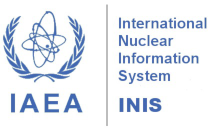In vivo monitoring in radiological or nuclear emergencies: a program for intercomparison of detection efficiency in NaI(Tl) portable detectors
DOI:
https://doi.org/10.15392/2319-0612.2025.2895Keywords:
internal dosimetry, intercomparison exercises, portable detector efficienciesAbstract
In vivo internal monitoring is a laboratory technique used to assess and quantify the incorporation of radionuclides in the human body. Demand for such services may increase significantly in a radiological or nuclear emergency. In addition to dedicated laboratories, researchers have proposed the calibration of portable gamma radiation detectors to carry out a rapid screening of exposed individuals and assess internal dosimetry. Several international intercomparison exercises have been conducted to evaluate the performance of detectors specifically designed for internal monitoring, including, more recently, NaI(Tl) portable detectors. However, these experimental intercomparison exercises have included the transport of radioactive sources between participating institutions. The aim of this study is to propose a simple methodology for determining a reference value for the NaI(Tl) detector efficiency at 662 keV (137Cs), supporting future exercise efforts. This work employed NaI(Tl) scintillator detectors and a torso phantom. It was possible to determine an optimized measurement geometry through simulation using the MCNPX mathematical code, especially regarding the distances, and to estimate efficiency values with defined acceptance intervals for the proposed intercomparison exercise. However, additional experiments are needed to define these intervals more precisely. Complementarily, the minimum detectable effective doses were approximately 60 µSv and 38 µSv for the NaI(Tl) 2’’×2’’ and 3’’×1.5’’ detectors, respectively.
Downloads
References
[1] INTERNATIONAL ATOMIC ENERGY AGENCY (IAEA). Assessment of Occupational Exposure Due to Intakes of Radionuclides. IAEA Safety Standards Series. No. RS-G-1.2, IAEA, Vienna, 1999.
[2] DANTAS, B. M., LUCENA, E. A., CARDOSO, J. S., LIMA, F. L., MENDES, B. M., RAMOS, M. P., DANTAS, A. L. A. In: BRAZILIAN CONGRESS ON IONIZING RADIATION METROLOGY 2019, Florianópolis, Brazil. Brazilian Network of In Vivo Monitoring Laboratories: Current situation and future prospects. Florianópolis: CBMRI, 2019.
[3] CICIANI, L.; VILARDI, I.; RIZZO, A.; ANTONACCI, G.; BATTISTI, P.; CASTELLANI, C. M.; SPERANDIO, L.. In vivo public monitoring in emergency exposure scenarios. The European Physical Journal Plus, Italy, v. 136, p. 1-15, 2021. DOI: https://doi.org/10.1140/epjp/s13360-021-01442-8
[4] SOARES, A. B.; LUCENA, E. A.; DANTAS, A. A.; ARBACH, M. N.; DANTAS, B. M.. Development and calibration of a portable detection device for in vivo measurement of high-energy photon emitters incorporated by humans. Brazilian Journal of Radiation Sciences, Brazil, v. 6, n. 2A (Suppl.), 2018. DOI: https://doi.org/10.15392/bjrs.v6i2A.438
[5] YOSHITOMI, H.; NISHINO S.; TANIMURA, Y.; TAKAHASHI, M.. A study of a calibration technique for a newly developed thyroid monitor and its uncertainties due to body size for radioiodine measurements. Radiation Measurements, Japan, v. 133, p. 106279, 2020. DOI: https://doi.org/10.1016/j.radmeas.2020.106279
[6] GALEEV, R.; BUTTERWECK, G.; BOSCHUNG, M.; HOFSTETTER-BOILLAT, B.; HOFFMANN, E.; MAYER, S.. Suitability of Portable Radionuclide Identifiers for Emergency Incorporation Monitoring. Radiation Protection Dosimetry, v. 173, n. 1-3, p. 145-150, 2017. DOI: https://doi.org/10.1093/rpd/ncw330
[7] PAIVA, F. G.; MENDES, B. M.; SILVA, T. A.; LACERDA, M.A.S; PINTO, J.R.; PRATES, S.; FILHO N.N.A.; DANTAS, A.L.A.; DANTAS, B.M.; FONSECA, T.C.F.. Calibration of the LDI/CDTN Whole Body Counter Using Three Physical Phantoms. Brazilian Journal of Radiation Sciences, Brazil, v. 5, n. 3, 2017. DOI: https://doi.org/10.15392/bjrs.v5i3.252
[8] MEDICI, S.; CARBONEZ, P.; DAMET, J.; BOCHUD, F.; PITZSCHKE, A.. Use of portable gamma spectrometers for triage monitoring following the intake of conventional and novel radionuclides. Radiation Measurements, v. 136, p. 106426, 2020. DOI: https://doi.org/10.1016/j.radmeas.2020.106426
[9] BOCHUD, F.; LAEDERMANN, J. P.; BAECHLER, S.; BAILAT, C.; BOSCHUNG, M.; AROUA, A.; MAYER, S.. Monte Carlo Simulation of a whole-Body Counter Using Igor Phantoms. Radiation Protection Dosimetry, v. 162, n. 3, p. 280-288, 2014. DOI: https://doi.org/10.1093/rpd/nct336
[10] ALMISNED, GHADA; M. H. ZAKALY, HESHAM; T. ALI., FATEMA; A. M. ISSA, SHAMS; ENE A, ANTOANETA; KILIC, GOKHAN; IVANOV, V.; TEKIN, H. O.. A closer look at the efficiency calibration of LaBr3 (Ce) and NaI (Tl) scintillation detectors using MCNPX for various types of nuclear investigations. Heliyon, v. 8, n. 10, 2022. DOI: https://doi.org/10.1016/j.heliyon.2022.e10839
[11] KNOLL, G. F.. Counting Statistics and Error Prediction. Radiation Detection and Measurement. Michigan: John Wiley & Sons, Inc, 2000. p. 86-96. ISBN 0-471-07338-5.
[12] CURRIER, LLOYD A.. Limits for Qualitative Detection and Quantitative Determination: Application to radiochemistry. Analytical Chemistry Division. National Bureau of Standards, v.40, n.3, p. 586-593, 1968. DOI: https://doi.org/10.1021/ac60259a007
[13] INTERNATIONAL COMMISSION ON RADIOLOGICAL PROTECTION (ICRP). Occupational Intakes of Radionuclides: Part 1. Publication nº 130, Oxford, 2015.
[14] INTERNATIONAL COMMISSION ON RADIOLOGICAL PROTECTION (ICRP). Occupational Intakes of Radionuclides: Part 3. Publication nº 137, Oxford, 2015.
[15] CASTELLANI, C. M.; ANDRÁSI, A.; GIUSSANI, A.; PÁZMÁNDI, T.; ROBERTS, G.. Preliminary Results of the Icidose 2017 International Intercomparison on Internal Dose Assessment. Radiation Protection Dosimetry, v.136, n. 4, p. 535-541, 2019. DOI: https://doi.org/10.1093/rpd/ncy160
[16] ARGONNE NATIONAL LABORATORY. Radiological and Chemical Fact Sheets to Support Health Risk Analyses for Contaminated Areas. U.S. Department of Energy (DOE), Illinois, 2007.
[17] WATERS, L. S. (2002). MCNPX User’s Manual Version 2.3.0. Los Alamos National Laboratory Los Alamos, New Mexico, 2002.
[18] MCCONN, R. J.; GESH, C.J.; PAGH, R.T.; RUCKER, R.A.; WILLIAMS, R.G. III. Radiation Portal Monitor Project: Compendium of Material Composition Data for Radiation Transport Modeling (PNNL-15870 Rev. 1). Pacific Northwest National Laboratory, 2011. DOI: https://doi.org/10.2172/1023125
[19] INTERNATIONAL STANDARD (ISO). Measurement of radioactivity — Gamma ray emitting radionuclides — Generic test method using gamma-ray spectrometry. British Standard, ISO 20042:2019(E), Geneva, 2019.
[20] MONTGOMERY, D. C. Design and Analysis of Experiments. 9th edition. John Wiley & Sons, Inc., 2017. ISBN 9781119113478.
[21] INTERNATIONAL ATOMIC ENERGY AGENCY (IAEA). Assessment of Occupational Exposure Due to Intakes of Radionuclides. VIENNA: v. No. RS-G-1.2, 1999.
[22] BERTELLI, L; MELO, D. R.; LIPSZTEIN, J.; CRUZ-SUAREZ R.. AIDE: Internal Dosimetry Software. Radiation Protection Dosimetry, Oxford, v. 130, n. 3, p. 358-367, 2008. DOI: https://doi.org/10.1093/rpd/ncn059
Published
Issue
Section
License
Copyright (c) 2025 MSc. Alexandre Barbosa Soares, Dr. José Ubiratan Delgado, Dr. Alfredo Lopes Ferreira Filho, Gabriel Flintz Fraga Marques

This work is licensed under a Creative Commons Attribution 4.0 International License.
Licensing: The BJRS articles are licensed under a Creative Commons Attribution 4.0 International License, which permits use, sharing, adaptation, distribution and reproduction in any medium or format, as long as you give appropriate credit to the original author(s) and the source, provide a link to the Creative Commons license, and indicate if changes were made. The images or other third party material in this article are included in the article’s Creative Commons license, unless indicated otherwise in a credit line to the material. If material is not included in the article’s Creative Commons license and your intended use is not permitted by statutory regulation or exceeds the permitted use, you will need to obtain permission directly from the copyright holder. To view a copy of this license, visit http://creativecommons.org/licenses/by/4.0/






















